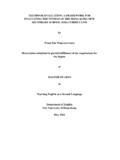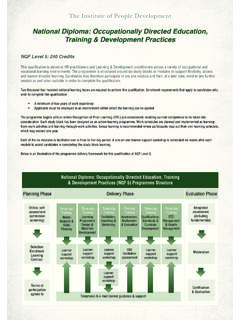Transcription of Online Assessment Techniques - acousticslab.org
1 Online Assessment Techniques Marcel Robles and Sandy Braathen Abstract The Online instructionaldelivery method should be used to facilitate teaching and promote learning. The obvious benefits of Online courses may be con- venience, flexibility,and "learning anytime, anywhere;" but teachers must ask if those benefits contribute to student learning outcomes. Online Assessment must be used to measure both learning objectives and application of knowledge. The Online educator should use Assessment Techniques to strategically reflect the pedagogy of Online courses. Many current Assessment Techniques can be modified to use in Online courses.
2 There are also other skills, such as written communication, that may be enhanced due to the Online deliveryof instruction. Introduction THE WORLD WIDE WEB has opened a whole new venue for teaching and learning. Online learning is here to stay! It is replacing many traditional classroom settings and is changing the ways in which we teach. Students will be able to learn what they want, when they want it, where they want to, how much they want, and, most importantly, will be able to assess what they have learned. The onus is now on the student. The student must be the active learner-self-disciplined, motivated, and learning through discovery.
3 Although educators at all levels have embraced using Online tech- nology as a teaching tool, the issue of Assessment of student learning in an Online course has not been thoroughly addressed. Although Online instruction may be more efficient, convenient, and flexible for both students and teachers, it must be stressed that this technology should be used to facilitate teaching and promote learning. As teachers, how do we know that we are fulfilling those requirements when we deliver instruc- tion Online ? Online Assessment ! As teachers reflect upon instructional methodologies and include Online learning as an instructional delivery mechanism, they must also reflect on their Assessment strategies.
4 The opportunity for Online educa- tion brings about new considerations in Assessment . Online Assessment is more than just testing and evaluation of students. By keeping in mind some basic tenets of Assessment , Online educators can adapt their assess- ment activities to provide useful feedback, accountability, and opportu- nities to demonstrate quality. Online Assessment should be viewed as a system for evaluating student academic achievement. The Assessment process should be viewed as a system because there are many components to measure. Just because it may be difficult to measure the amount of learning does not mean that learning has not taken place.
5 The idea is that if Online instructors keep improving their teaching strategies, the students will learn more. DR. MARCEL ROBLES is Chair and Assistant Professor in the Department of Information Systems and BuLsiness Education, College of Business and Public Administration, University of North Dakota, Grand Forks, ND 58202. DR. SANDRA BRAATHEN is an Assistant Professor in the Department of Information Systems and Business Education, College of Business and Public Administration, University of North Dakota, Grand Forks, ND 58202. VoL XLIV No. I Winter, 2002 39. MARCEL ROBLES AND SANDY BRAATHEN. A study conducted at the University of North Dakota explored the methodology, benefits, and challenges of conducting student Assessment in an Online course.
6 It compared student learning outcomes of an Online course with student learning outcomes of a traditional course. Several questions were derived from this study that suggests educators need to do more quality Assessment when they offer Online courses: 1. How can instructors be prepared to use Assessment methods effectively in the teaching of Online courses? 2. What methods of Assessment are necessary when delivering instruction Online ? 3. How are learning objectives measured with Online course curricula? 4. What are the pedagogical considerations for teaching Online courses? 5. How are critical thinking and problem solving assessed with this type of instruction?
7 6. How is student learning evaluated and assessed? The focus of this article is to address these questions in three steps: first, by looking at how Assessment in Online courses is similar to Assessment in traditional courses; second, by looking at how Assessment in Online courses is different from Assessment in traditional courses; and third, by summarizing Online Assessment Techniques . Traditional Assessment Techniques Whether teachers are delivering instruction in a traditional classroom or over the Internet, Assessment instruments should be designed to provide students with immediate feedback and help them to understand and apply what they have learned.
8 Students need to see the "fit" of the material with a real-world application. Courses must have learning objectives as their criteria, Assessment methods to measure student learn- ing outcomes, and feedback components to and from the student. Three key components of Assessment are (1) measurement of the learning objectives, (2) self-assessments for students to measure their own achievement, and (3) interaction and feedback between and among the instructor and students. Business educators must be careful to avoid the trap of simply using tests for Assessment . Assessment needs to be more than a series of standardized tests or even end-of-the-term exams.
9 Graded tests alone are not enough; tests are evaluation tools for assigning grades. Self-testing can be an effective tool for Assessment . Self-tests should be used by students to assess their ability or level of understanding. Often, teachers do not even see the scores of self-tests. However, one way teachers could use self-tests is to identify weaknesses in the curriculum or content areas needing supplementary material. A second trap to avoid is assessing students on subject matter that was not included in the course content, frustrating students and giving the teacher inaccurate results. This problem is typically a result of not aligning Assessment with the learning objectives and the subject matter.
10 40 The Delta Pi EpsilonJournal Online Assessment Techniques . The learning objectives must be clearly defined for the students as well as for the instructor. The Assessment tools must reflect the desired learning outcome. Each time the course is offered, the learning objectives should be examined. Types of Assessment Zeliff and Schultz (1998) identify three types of Assessment used to provide feedback for students in business education: traditional, alternative, and performance. Traditional Assessment typically measures lower-level cognitive skills. This domain includes factual recall and comprehension.








